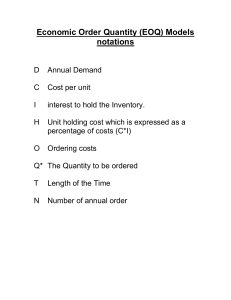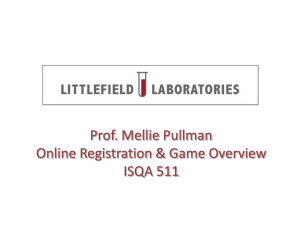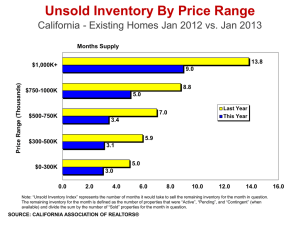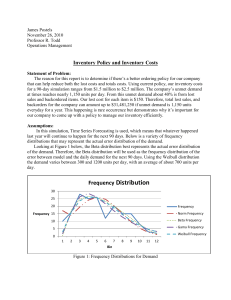Inventory Planning & Control
advertisement
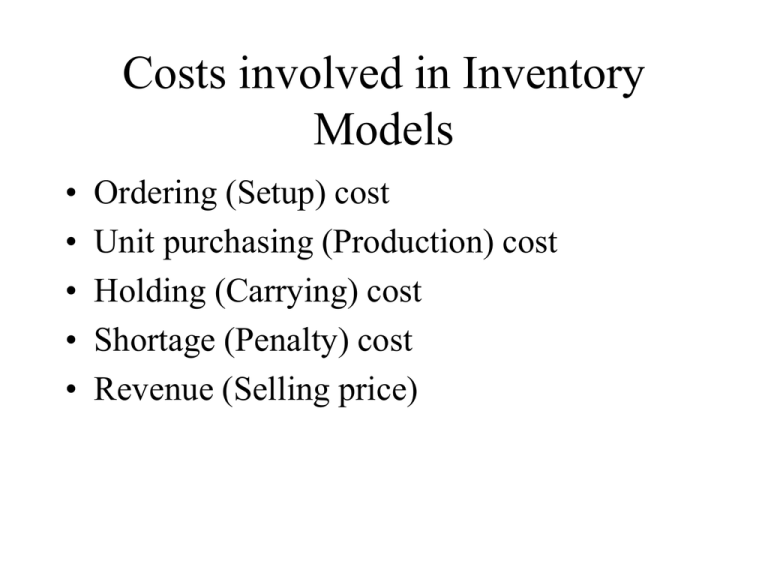
Costs involved in Inventory Models • • • • • Ordering (Setup) cost Unit purchasing (Production) cost Holding (Carrying) cost Shortage (Penalty) cost Revenue (Selling price) Basic EOQ Model • EOQ: Economic Order Quantity • Assumptions of EOQ models: – Demand is constant (unvarying ), expressed as annual demand (units per year ). – Models use continuous review, not periodic review. – Lead time is constant & known. – Quantity discounts are not possible. – 2 variable costs: setup cost and holding cost. Inventory Levels • Inventory vs. time. Usage rate (D) Reorder Point (ROP) Lead time ( L, l ) Cycle time (T) time Symbols in EOQ models • • • • • Order quantity: Optimal order quantity: Annual demand (units): Setup cost per order: Holding cost (per unit): Q Q* D K H Annual Cost Total Cost vs. Order Quantity. Combined curve: holding & setup. Minimum annual cost We’ll find an equation for this amount Optimal order quantity Holding cost curve Setup cost curve Order Quantity Annual setup cost: equation • What is related to it? Q, K, & D demand / quantity per order = # of orders. # of orders * K = annual setup cost. D Annual setup cost = *K Q Annual holding cost: equation. • Q: order quantity Q & H. • inventory is replenished precisely when no inventory remains. • Average inventory = Q/2 Constant slope Q time Annual holding cost: equation. Q Annual holding cost = *H 2 Q time Finding where they are equal. • The minimum cost of the system will be found where ASC = AHC. D ASC = *K Q Q AHC = *H 2 Solve for Q • The minimum cost of the system will be found where ASC = AHC. D *K = Q Q *H 2 Solve for Q • The minimum cost of the system will be found where ASC = AHC. 2DK = Q2 H Solve for Q • The optimal order quantity that results in the lowest system cost is called Q* 2DK = Q* H Holding costs • Total annual holding cost: inc. monetary value of inventory, annual cost of capital, storage costs: Hc = cQ 2 Holding costs • Total annual holding cost: inc. monetary value of inventory, annual cost of capital, storage costs: Hf = i * cQ 2 Holding costs • Total annual holding cost: inc. monetary value of inventory, annual cost of capital, storage costs: Hs = sQ 2 Total holding costs • Total annual holding cost: inc. monetary value of inventory, annual cost of capital, storage costs: (s+ic)Q Ht = 2 Other factors (lurking in the shadows) • Unit cost (production cost): cost per unit to buy the inventory: symbol “c” • Annual unit cost = cD Other factors (lurking in the shadows) • Revenue: profit per unit of inventory sold: symbol “r” • Annual revenue = rD Total Cost of the System DK ( s + i c ) Q Total cost = cD + + Q 2 Cost of the products Cost of ordering Cost of inventory Determine reorder point • Demand is constant. Lead time is known. ROP L = Q T Q ROP time L MS Excel example • (Go to it) Homework: due Thursday • p. 470, #1, 2, 4 - turn in ON PAPER (preferably computer printouts, each on 1 sheet of paper that can be understood by someone who WASN’T there when you set it up.) Preview of Thurs.: 2 other models (ind. D) • Production Order Quantity Model • Quantity Discount Model

